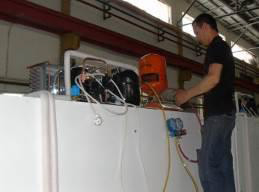 ‘Change’ is simple to do, but it is by no means easy. This is especially the case when the change involves a shift from a simple and economically-advantageous practice, to one that challenges accepted business practices, but has a broad and important impact on the environment.
‘Change’ is simple to do, but it is by no means easy. This is especially the case when the change involves a shift from a simple and economically-advantageous practice, to one that challenges accepted business practices, but has a broad and important impact on the environment.
The need to protect the Ozone Layer is a fundamental challenge that has been faced since the 1970s. Scientists around the globe have proven that without humans taking due care and re-evaluating their actions, they could very well cause a range of destructive impacts. For key stakeholders including companies within the food industry, changing traditional and lucrative practices to those that will protect the earth requires much more courage and responsibility.
In collaboration with the ‘Initial Implementation of Accelerated HCFC Phase-out in the CEIT Region’ project, operated by UNDP, the State Committee for Nature Protection of Uzbekistan and the Global Environmental Facility, several companies in Uzbekistan have made bold but rewarding decisions to actively reduce their use of Ozone Depleting Substances. Below we present two of their stories.
A change in approach
“Introducing new industrial practices involves investments of time and money, for training, buying new equipment, and changing approaches,” said Stranislav Valaboev, the Executive Director ‘AZN’ refrigerator company based in Tashkent, Uzbekistan. “From 2013, at our own expense we stopped using ODS – HCFC 141b in our manufacturing processes, in accordance with the Montreal Protocol on Substances that Deplete the Ozone Layer.”
ODS – HCFC 141b is a hydrochlorofluorocarbon used in the manufacturing of refrigerators and building insulation. When the chemicals enter the atmosphere they change the structure of the Ozone Layer, thinning the layer and causing additional UV rays to pass through the zone to the earth’s surface. These rays can increase levels of skin cancer and cataracts, while also damaging plants and reducing ocean plankton populations.
With support from the project, the ‘AZN’ company from 2013 stopped its use of ODS – HCFC 141b in the manufacturing of thermal insulation equipment, and since 2014 ozone-friendly technologies have been utilized in manufacturing processes. The company has also trained staff in the need to phase out Ozone Depleting Substances such as HCFC 22, along with the need to address climate change problems caused by global warming.
Switching the processes used in refrigerator manufacturing has not been easy for the company, but it has been necessary. The process has involved retrofitting the company’s factory, introducing new technology into existing infrastructure, and investing in a change of employee mentality towards the Ozone Layer. It’s been a long term investment, but one that is important for long-term change.
“We want to become further involved in the UNDP Uzbekistan project, as part of the demonstration component,” said representative of company Holod System, specified in production refrigeration equipment in Tashkent. “We will transition to filling the refrigeration units of some models with the R 290 (propane) natural refrigerant, in order to entirely phase out the HFC refrigerants group in the future. It’s important that we set a good example.”
Better supermarkets
As Uzbekistan’s largest supermarket chain, support from ‘KORZINKA.UZ’ has been crucial in limiting the use of HCFCs. The company’s plan to limit HCFC use is long-term, multifaceted and sustainable, and has overcome some limitations including a lack of qualified technicians, and problems faced in accessing necessary products and equipment in large enough quantities. Still the company is dedicated to establishing long-term change.
“KORZINKA.UZ is a bright example of HCFC reduction in the food retail business,” said specialist of the HVAC and refrigeration installation and maintenance department Kamoliddin Nastritdinov. “We are carrying out a number of procedures aimed towards achieving HCFC output limitation measures, including regular leak tests, and recovering and recycling HCFC-containing systems for repair shutdown periods.”
With UNDP’s support, in September representatives from the chain attended a training held in the city of Casale Monferrato in Italy, in order to make sure the obtained knowledge and skills can contribute to the work processes. Seminars on reducing HCFC impacts are to be conducted in the coming month, with an expected long-term impact of increasing the quality of services available to refrigeration service companies. It is expected that in the remainder of 2015 and in 2016, more than 800 refrigeration technicians nationwide will be involved in trainings organized by the project.
“As a major measure in limiting HCFC outputs, our company has quit buying equipment designed for HCFC, and has taken certain steps to retrofit HCFC-containing systems in the future. Also the company has a great interest in utilizing natural refrigerant-based equipment for blast freezing,” Mr. Nastritdinov said. “We will need continued help from UNDP Uzbekistan in achieving this outcome.”
Limiting HCFCs nationwide
Currently at midday through its timeframe, the ‘Initial Implementation of Accelerated HCFC Phase Out in the CEIT Region’ is halfway through its implementation, and a key component of a global initiative to reduce the production and use of ozone-depleting substances. It has sought to control HCFC imports, while ensuring equipment limiting the use of HCFCS are utilized.
The project intends to provide technicians of public and private refrigeration and air-conditioning companies with modern refrigeration equipment. With appropriate training, technicians can use the equipment to decrease fugitive emissions of ozone depleting substances. In 2016, five ODS recycling and regeneration centers will start their operations, supporting the improvement of national ODS re-use infrastructure in Uzbekistan, and decreasing the import of ODS.
UNDP, 28 October 2015, By International Blogging Consultant James Brindley, and HCFC project manager Abror Khodjaev
